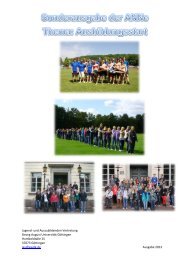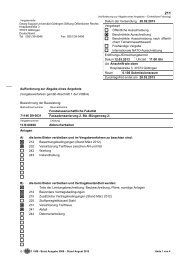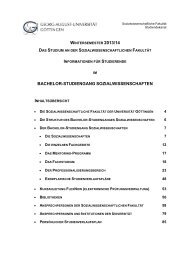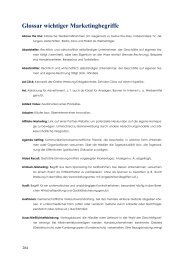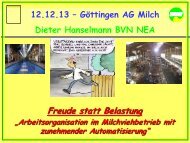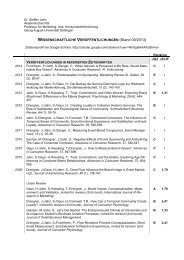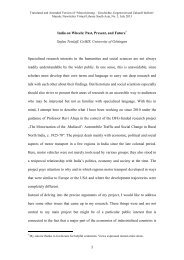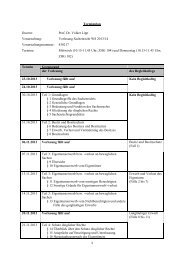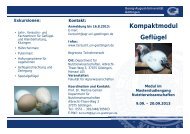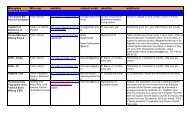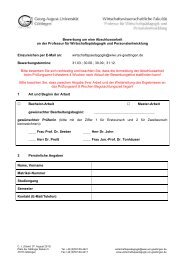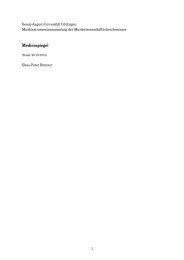CRC 990 - EFForTS - Georg-August-Universität Göttingen
CRC 990 - EFForTS - Georg-August-Universität Göttingen
CRC 990 - EFForTS - Georg-August-Universität Göttingen
You also want an ePaper? Increase the reach of your titles
YUMPU automatically turns print PDFs into web optimized ePapers that Google loves.
<strong>CRC</strong> <strong>990</strong> Ecological and Socioeconomic Functions of Tropical Lowland Rainforest Transformation Systems (Sumatra, Indonesia) Issue 1 / <strong>August</strong> 2013<br />
page 16 von 32<br />
Ecological / economic functions<br />
Tropical<br />
lowland<br />
forest<br />
Agroforest<br />
Monoculture<br />
plantation<br />
Short-term<br />
economic<br />
profitability<br />
Other socioeconomic<br />
functions<br />
Diversity of<br />
ecological<br />
functions<br />
Figure: Sketch of the hypotheses regarding the ecological and<br />
socio-economic functions across tropical transformation systems<br />
in Jambi, Indonesia<br />
Figure: Result of participative assessment of divides in methods<br />
and approaches between and among ecological and socio-economic<br />
functions.<br />
Focus 2:<br />
Title: Quantifying the effects of spatial and temporal<br />
variability on ecological<br />
and socioeconomic functions<br />
Representatives: Holger Kreft & Stefan Schwarze<br />
Understanding ecological and socio-economic functions<br />
in transformation systems requires information<br />
about the spatial and temporal variability that is inherent<br />
in the different systems. For instance, within<br />
transformation systems, we expect large differences in<br />
profitability, risk, biodiversity and ecological functions.<br />
Quantifying this variability is crucial for landscape-level<br />
assessments, up-scaling (compare also focus 3) or to<br />
assess long-term temporal trends. Focus 2 aims at addressing<br />
such spatial and temporal variability.<br />
Recent activities in this focus include a longer planning<br />
meeting on 05 March 2013 where 13 people representing<br />
all three project groups A-C participated. The main<br />
aim was to identify shortcomings in the pertinent literature<br />
and to evaluate the potential for collaborative<br />
synthesis papers. It was noted that previous studies<br />
almost exclusively quantified local-scale effects at the<br />
plot level without considering neither spatial nor temporal<br />
variability (e.g. Fitzherbert et al. 2008, Trends Ecol<br />
Evol). Another shortcoming identified is that previous<br />
studies have been based on rather patchy data sources.<br />
It thus appeared to be most promising and obvious<br />
to address first the spatial variability as<br />
longer time series would be needed to<br />
look into temporal aspects.<br />
Thus, next steps towards a first synthesis paper under<br />
the working title “Quantifying the effects of spatial variability<br />
on ecological and socio-economic functions in<br />
rainforest transformation systems were planned”. It<br />
is the aim that all project groups can contribute data<br />
to such a paper and that it takes full advantage of the<br />
common <strong>CRC</strong> study design.<br />
Research group A would primarily deliver soil parameters<br />
such as carbon stocks, nutrient availability (N, P,<br />
Ca, Mg, K etc. ) and pH that serve as indicators of the<br />
spatial variability in environmental conditions. Group B<br />
would contribute with a wealth of biodiversity data for<br />
different taxonomic groups (incl. macro-invertebrates,<br />
prokaryotes, vascular plants, soil micro- and mesofauna,<br />
mycorrhizal fungi, epigeic fauna). Finally, C groups<br />
would quantify return-on-land. On 08 April 2013, a follow-up<br />
meeting took place that clarified issue on how<br />
to bring together differently scaled variables (e.g. nominal,<br />
continuous) and approaches (additive diversity<br />
partioning vs. analysis of variance components) under<br />
a common framework and which statistical approach<br />
would be best suited for analysis.<br />
www.uni-goettingen.de/de/310995.html • crc<strong>990</strong>@gwdg.de • Telephone: +49 551 39-1 21 18<br />
JFB Institute for Zoology & Anthropology • Berliner Strasse 28 • D-37073 <strong>Göttingen</strong>




